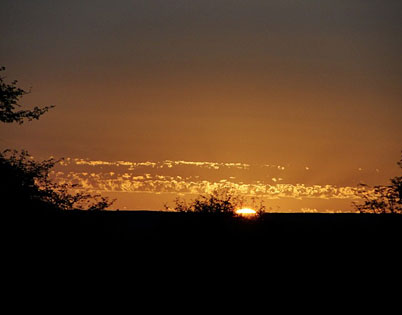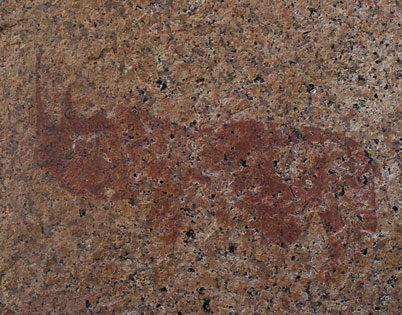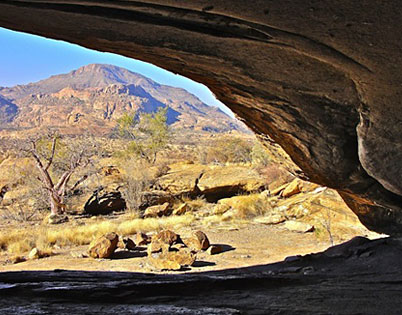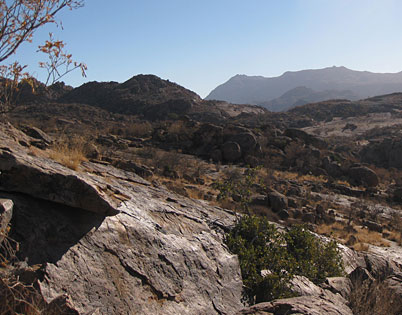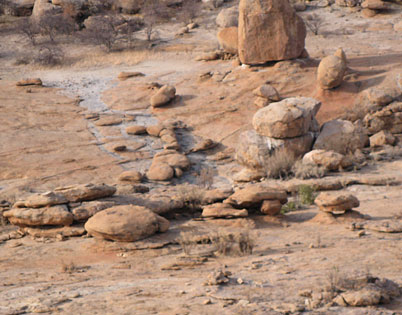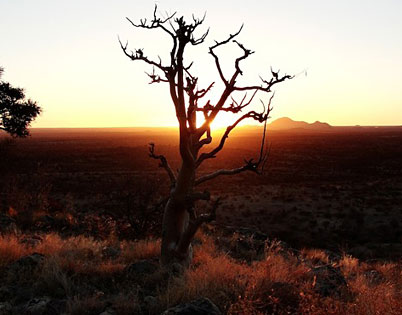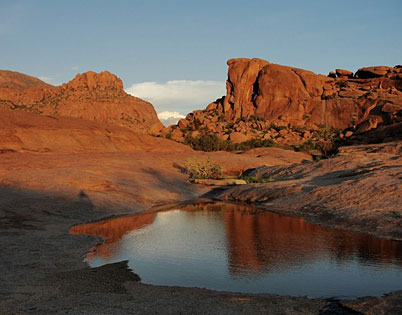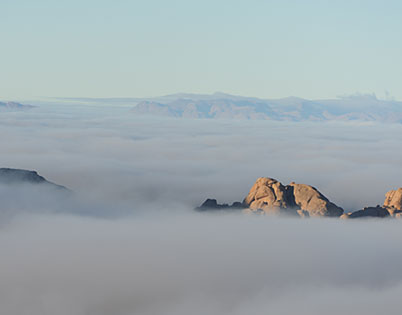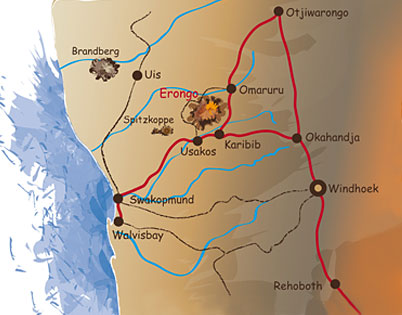ERONGO MOUNTAIN RINO SANCTUARY TRUST OF NAMIBIA
– Model for the Protection of Game and the Conservation of Nature in Southern Africa
The ERONGO Mountains, located at the heart of Namibia, half way between Windhoek and Swakopmund, are one of the oldest volcano crater mountains in the world. The area has retained much of its original beauty and pristine nature, despite the presence of people and the closeness to the small town of Omaruru. Impenetrable scrubland as far as the eye can see, still home to a largely unspoilt animal and plant world, is interrupted by majestic heights with inaccessible gorges and gigantic rock formations.
In this largely unspoilt countryside, species of game such as the Black Rhinos, Black-Nose Impalas, the Greater Kudu, Oryx, Hartmann’s Zebras and Klipspringers have their home since time immemorial, are hunting Leopards, spotted Hyenas and Brown Hyenas, also called Beach Wolf, are living Springboks and Warthogs, as well as many other representatives of wildlife as well as occasionally once again elephants.
That the Erongo has been home to people for thousands of years, is suggested by numerous petroglyphs, artfully manufactured by Bushmen long before our era.

The Erongo Mountain Rhino Sanctuary Trust (EMRST) of Namibia
The EMRST is an initiative based on – and in thankful recognition of – the Policy of Sustainable Use of Natural Resources by the Namibian Government and the incentives created thereby to carry on nature conservation even outside of National Parks. Started as a conservancy in 1998 by a few individuals carried by the belief that true nature conservation always should be subordinated to a bigger picture, that individual conservation measures should always take into account and be subordinated to ecosystems, which are bigger than individual properties, the project grew into it’s present state with constant guiding and support by members of the Namibian Ministry of Environment and Tourism.
The endangered black rhinoceros, Diceros bicornis bicornis, which occurred naturally in the Erongo Mountains (the last specimens where translocated into Etosha National Park in 1974), played a major role in the considerations to form a private Nature Sanctuary in and around the Erongo Mountains in western Namibia. The Project is also based on the belief that nature conservation projects should portray natural circumstances of the area in which they are carried on.

Therefor only indigenous Namibian species are protected within the project, placing special emphasis on endangered species and endemic species. As such the black rhinoceros and the endemic black faced impala, Aeceros melampus petersii, play an important role. Starting from humble beginnings, the project now has grown into a state where a number of tourist lodges, guest and hunting farms and campsites contribute largely to job creation and attract an important number of tourists. Moreover an important number of black rhinoceros and black-faced impala, as well as numerous other indigenous Namibian species, are protected. As such the EMRST can act as showcase of Namibia’s natural splendour and as successful implementation of the policy of the Sustainable Use of Natural Resources of the Namibian Government above and beyond mere individual interests.
Location and envisaged ideal boundaries
The project presently encompasses 20 member farms and 12 geographically incorporated supportive nonmember farm units within and surrounding the Erongo Mountains in western Namibia. The project encompasses an area of approx. 180 000 Ha. Important ecological features are the mountains itself, as well as the thornveld savannah surrounding it and two major water-courses (the Omaruru River to the north and the Khan River to the south). These features allow for a seasonal movement of wild animals within the Project.
Protection of the endangered black rhinoceros
The black rhinoceros Diceros bicornis bicornis historically occurred in the Erongo Mountains, as is proven by numerous rock paintings depicting this species and numerous rhino rubbing stones throughout the area. Even in recent times black rhino still occurred in the Erongo Mountains, the last specimens where translocated to Etosha National Park by the authorities as late as 1974.
This was encouragement for us to try and reintroduce this endangered species into the area and right from the start was one of our priorities. The inspection carried out by Mr Rudi Loutit from the MET, came to the conclusion that the area has the potential to become a rhino sanctuary of world importance, the carrying capacity was estimated to be at least 70 animals. This served as further encouragement for us and we eventually became a partner in the Black Rhinoceros Custodianship Programme of the MET. We are truly proud and thankful to be part of this project.
From 2008 onwards animals, bulls and cows, where introduced into the area. We try all humanly possible to safeguard their safety. We conduct daily anti poaching patrols, have installed camera systems and have Gyro Copters to our dispos

Protection of the endangered endemic black-faced impala
Just like is the case with the black rhino, we feel an obligation to contribute to the protection of another endangered Namibian species, the endemic black-faced impala.
Since the start of our project we have built up, from an initial introduction of animals a very healthy population.
Protection of indigenous Namibian species
Within our area all the endemic Namibian ungulates, namely Hartmanns zebra, Damara dik dik and black faced impala occur. Moreover nine Namibian endemic bird species and other endemics like for example the Angolan dwarf python and the black mongoose are found and enjoy full protection.
Apart from the endemic species it also has to be noted that rare and endangered species like for example brown hyenas, leopard and cheetah, as well as peregrine falcon and booted eagle in breeding populations, are present. Of course the typical Namibian game animals like kudu, gemsbok, springbok, etc. occur. We have re-introduced giraffe and eland and built up stable numbers of these species.
The ERONGO MOUNTAIN RHINO SANTUARY TRUST OF NAMIBIA is a Namibian Law foundation. It was established on the 3rd of July in 2006 before the Namibian notary public Friedrich Cristian Brandt, residing in Windhoek, and registered on the 22nd Of February 2007 by the master of the HIGH COURT at the Ministry of Justice in Windhoek, Namibia, under registration number T 235 / 06.
Objectives of the EMRST
3.1
To be a charitable, benevolent, non-profit trust company, which was founded in order to establish a private nature reserve by combining private land, and thus forms the Erongo Mountain Rhino Sanctuary of Namibia in the area of the Erongo Mountains, to, among other things, acquire the necessary consent of the Ministry of Environment and Tourism of the Republic of Namibia, to accommodate the endangered Black Rhinos within the Erongo Mountain Rhino Sanctuary of Namibia and to be responsible for all land under the administration of the trust company for the purpose of nature conservation, in accordance with the following objectives, is managed and controlled, but subject to the rights of the land owners;
3.2
To support, to encourage and to have carried out the proclamation as a protected area of all land that is under the administration of the trust company, in order to have sole use of the conservation area and to devote to long-term conservation;
3.3
To expand the scope and scale of the protected area whenever this is reasonably possible and is in the national interest, and based on the fact that there are no fences within the protected area (except for parts, which have a maximum size of 20 acres around existing homesteads and farms , which are part of the protected area);
3.4
To protect the Erongo Mountains as a unique "island mountain habitat" within the Namibian Escarpment with its wealth of local and rare species, and to reintroduce such species that historically once lived in this area, in order to lead the wildlife in this area to the full spectrum of the types that are appropriate in this area;
3.5
To protect natural and scenic areas of national and international importance, for the sake of the animal world, for spiritual, scientific, educational, cultural, recreational - or tourist purposes;
3.6
To maintain representative examples of physiographic regions, biotic communities, genetic resources and species, consisting of the natural heritage of Namibia, and, if necessary, to restore to a most natural state, in order support the ecological stability and diversity;
3.7
To maintain the usage by visitors for inspirational, educational, cultural and recreational purposes in a way that preserves the area in a natural state, but is subject to the rights of the owners, as listed in Appendix "A".
3.8
To eliminate a usage or claim, which is detrimental to the purposes for which the land has been determined, and, as a result, to prevent it;
3.9
To maintain and to support respect for the environmental geomorphology, sacred or aesthetic attributes, which ensures the provision of each protected area;
3.10
To contribute to the well-being of the local population in the national interest and to create jobs for the local population as well as to generate exchange revenues, to contribute to the recovery of the people of the region and Namibia in general;
3.11
To manage and maintain the Erongo Rhino Sanctuary under the application of the principles for a sustainable use of natural resources through hunting or other means of sustainable use, and to use a surplus of wildlife in the best interest of the species in this habitat, whereas the best strategies must be applied, without hurting or violating the ethics of hunting. Also, the criteria of the working group of African and professional hunters for a sustainable use of natural resources by hunting, are included in the ethics of hunting, which are published in the ERONGO directory. The Erongo Mountain Rhino Sanctuary Trust of Namibia encourages therefore the work of this working group of African hunters and professional hunters, also regarding the further development of the criteria for the sustainable use of natural resources through hunting. It supports therefore the ERONGO directory, at the same time as its official communication organ;
3.12
To strive after, within the parameters of strict ethical disciplined conduct and strict solid principles of conservation principles, a balanced equilibrium between economic and ecological viability of the protected areas;
3.13
To preserve endangered species and to multiply those to such a number that they can be relocated to other adequately protected areas of life;
3.14
To adequately manage the habitat in accordance with their requirements and priority levels, so that such threatened and endangered species can be hosted;
3.15
To systematically remove, as far as practicable and reasonable, non-local / area-foreign animals and plant life within all protected areas managed by the trust company, with the understanding that landowners cannot be forced to remove non-native animals and plants, which already existed in the areas protected by the trust at the time of the creation of the trust;
3.16
To strive after the creation of an optimally used and cost effective, functional nature conservation operation, which is free of corruption and abuse, which is managed with discipline, and to secure all areas managed by the trust company for visits;
3.17
To support and ensure the concept of respect and inviolability of all wild, primarily acceptable principles based on the protection of natural habitats and sustainable ethical use;
3.18
To operate protected areas in such a way that the wonders of nature are taught to the people, and improve with all possible means the continuous protection against the abuse of wild animals;
3.19
To basically do everything to improve the ethical teachings of nature conservation;
3.20
Without coming into conflict regarding the statements above, the individual land owners in their capacity as an private persons, are entitled to exercise their rights as stated in annex ‘A’ and to develop facilities for tourists in order to be able to offer a high-quality approach to nature to the joy of all people around the world, especially the people of Namibia;
3.21
To form all areas managed by the trust company as a showpiece and standard, which can be sustained for the defence of the natural heritage according to the principles of sustainable nature conservation in national and international areas;
3.22
To principally promote and support the success of nature conservation in the Southern African region and to encourage other efforts of preservation in places, where it appears appropriate and useful, to join forces with them to a common conservation front where necessary in order to achieve secure conservation objectives in national and international interest;
3.23
To support recognition of the social, economic, and moral values of nature conservation worldwide and to show that nature protection as a form of land use can in most cases at least positively compete with alternative land use in social, economic and scientific terms;
The ERONGO MOUNTAIN RHINO SANCTURARY TRUST OF NAMIBIA is also the spiritual carrier of the ERONGO directory for African game.
The name is dedicated to the working party of experienced African professional hunters as well as to the journal published by them, which is at the same time the official communication organ of the EMRST.
The ethic of hunting also includes the criteria of the working group of experienced African hunters and professional hunters for a sustainable use of natural resources by hunting, and is published by them in the ERONGO directory for African game. The EMRST supports this working group regarding the development of these criteria. It also supports the publications of the ERONGO directory, at the same time as its official organ of communication.



